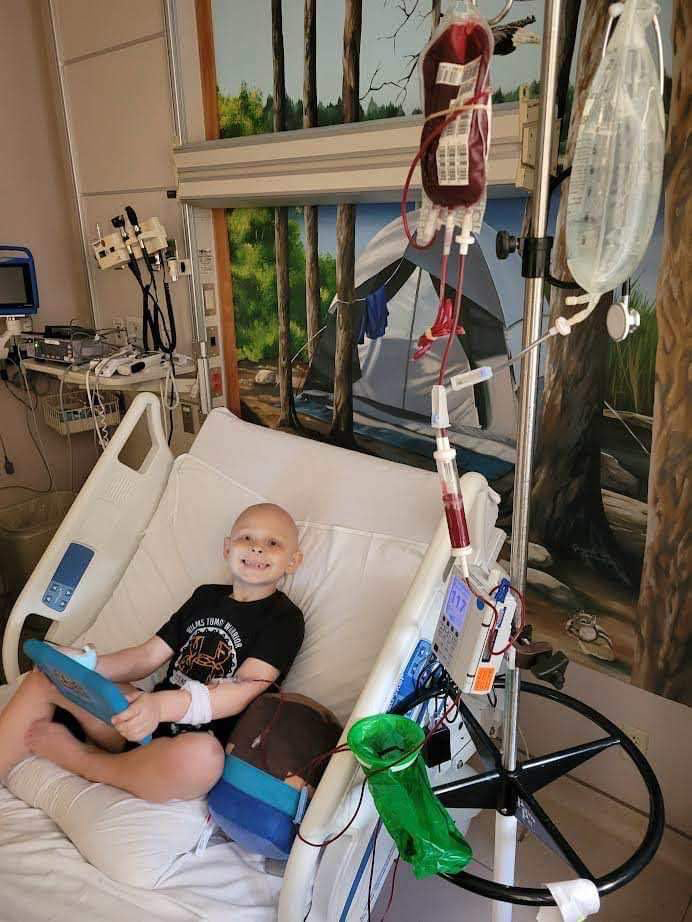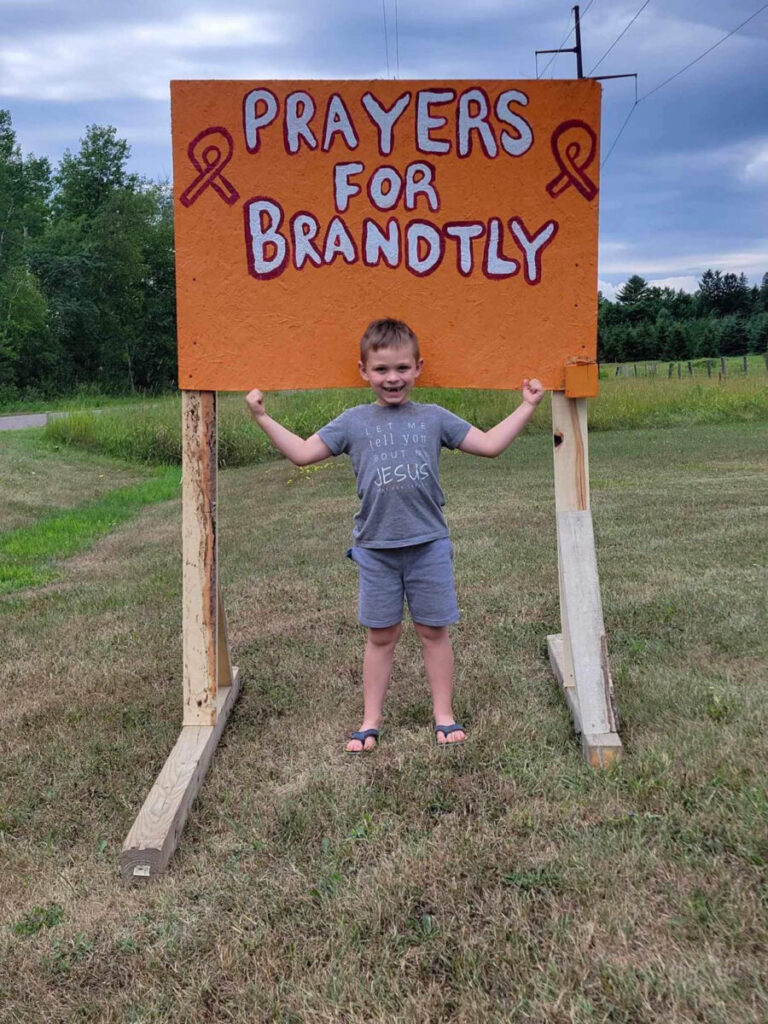Brandtly’s story showcases just one of the needs for blood donors

BY TINA L. SCOTT
EDITOR
Imagine you’re having just a regular night at home with your family and you are casually rubbing your four-year-old child’s back/side before bedtime when you notice a lump. At first, you try not to think much about it. He’s a little boy, maybe it’s some easily remedied cause. Still, there’s an anxious little niggling at the back of your parent mind and it won’t go away. What if it’s something more serious? You don’t even dare to think the word cancer. That’s the kind of thing that happens to other people, other families, other children. Not to yours.
So you go to bed and carry on, but plan to take your child to the doctor to have it checked out the next day, just to be sure.
That’s precisely what happened to Hailey Clark on Nov. 8, 2021, just six days after her son, Brandtly, turned four years old.
“We were laying on the couch. And I was rubbing his back and side before bed,” Hailey said. “That’s when I felt the lump. And as I was kind of pushing around it, he said it was hurting. But it didn’t hurt if I didn’t touch it. You were unable to see it with the naked eye.”
He had been sick the week before, so she thought perhaps it was related and tried not to make too much of it, but she did take him in to have it checked out the very next day.
In the days that followed, Matthew and Hailey Clark’s world became a whirlwind as they took their son, Brandtly, to the Emergency Room and he underwent tests. Then they received the devastating news, based on a cat scan of the area, that doctors believed their little boy had cancer and he needed surgery. The exact kind of cancer? Nephroblastoma, a solid cancerous tumor of the kidney more commonly called a Wilms Tumor, named after the German surgeon who first described it, mostly commonly found in children. “Wilms Tumor is the fourth most common type of childhoold cancer and the most common type of kidney cancer in children” according to the St. Jude Children’s Research Hospital. “About 500 new cases of Wilms Tumor are found each year in the United States, affecting about 1 in every 10,000 children.”
“The next week they did surgery to remove his left kidney and the tumor (that was inside) and that’s when it was confirmed that it was Wilm’s Tumor by Children’s Hospital in Milwaukee,” Hailey said. [Officially Children’s Wisconsin-Milwaukee Campus]
“We were there for a total of nine days,” Hailey said. “Our surgeon, Dr. Jack Schneider, really gave us the most sense of calmness during that time. Our emotions were overflowing but with not knowing how the next day would even go, it kept us on edge. But Milwaukee Children’s Hospital was outstanding!”
When removed, Brandtly’s kidney was about three times the size of a normal kidney for a child his age, Hailey said.
“He started chemo and radiation right away,” she said. “He did one day a week for four weeks. Then one day a week, every other week, for twelve weeks. Then one day every three weeks for nine weeks.” After treatments, Brandtly was sick for two to three days with nausea, fatigue, and no appetite. Then after about five days, he started feeling back to normal. Then the cycle started all over again. That was from Nov. 29, 2021, until May 31, 2022. It was a long six months for the family.
But the treatment proved successful. “He had a scan June 2022 which declared him cancer free,” Hailey said. “We celebrated with cake and ice cream.”
Then the family planned a trip to the beach, and that was made possible through the generosity of Make-A-Wish Foundation in February 2023, she said.
Follow up was for Brandtly to have scans every three months for the next three years. They started that protocol and “We celebrated EVERY three months when we got clear scans,” Hailey said.
Relapse
Then, earlier this year, “On his one-year scan, June 12, 2023, they found a spot on his right lung,” she said. A July 7 biopsy confirmed it was a relapse of Wilms. While Wilms relapse is not uncommon and tends to occur within two years after the primary diagnosis, and while the most common site for metastic spread of Wilms Tumor is in the lungs, it was nonetheless devastating for Brandtly’s parents to hear their son’s cancer, once in remission, was now back.
“Hearing your child has cancer is the worst feeling,” Hailey said. “but hearing it twice is even worse. You feel like everything you did the first time was pointless. Having to tell your five-year-old he has to do it again was the one of the worst feelings I’ve ever had.”
“When he asked, ‘Why did it come back?’ it was something our hearts just couldn’t handle,” she said. “But you don’t have a choice but to move forward. It’s each day at a time; you really can’t think or plan ahead.”
“His diagnosis (both times) has favorable histology,” Hailey said. “He was stage four the first time, and a replase is an automatic stage four diagnosis again.”
“There isn’t a standard protocol for a relapse of Wilms,” she said, “The Tumor Board (many doctors from Marshfield and Milwaukee discuss cases and brainstorm with each other on every case) suggested we enter a clinical trial for the relapse of Wilms.”
The clinical trial is every 21 days, with two different regimens, Hailey eplained. Regimen one is three days of chemo (seven hour treatments) followed with 12-16 hours of hydration and a medication called mesna because one chemo is extremely hard on the bladder. Regimen two is five days of chemo (only takes about an hour) and each day of treatment he is given steroids. He also has six different options for nausea medications that they rotate for about four to seven days after treatment. This is 10 cycles.
They usually do a CBC (complete blood count) before he leaves the hospital after getting treatment.
They started the clinical trial July 24, 2023, and the plan is to finish Feb. 5, 2024. “After the Last chemo, between 24-72 hours, he has to recieve a filgrastim shot (bone marrow stimulant),” she said.
While going through all of this treatment, Brandtly needs weekly blood draws “to check his numbers to make sure his counts are going up,” Hailey said. “We get those done in Merrill.”
She said they usually get the results within 30 minutes, but if his blood counts are down, Brandtly then needs to receive blood or platelet transfusions. “Blood transfusion depends on his hemoglobin level, which needs to be 7.5 or below. And his platelets below 20,” she said. “He could have one or the other or need both.”
If Brandtly needs a blood transfusion, that takes three hours, or a platlet transfusion, that takes an hour. Over the course of treatment, he has needed several of both. “This can only be done in Marshfield,” she said. “So away we go to spend the day there, and then usually need another blood check within a couple days.”
On a fun side note, “We always have to stop at Chip’s Hamburgers on the way home,” Hailey said. “It’s his favorite.”
Community support
“Our daily lives are like a tornado,” Hailey said. “A fever can spike at any point. If this happens, we have to head straight to Marshfield, we need a blood draw to check for infection, and antibiotics with a two-day minimum stay. Our bags are always packed. We’ve had a few runs to the hospital in the middle of the night.”
“Just like the first time, our family and friends really stepped up to the plate to help with our now three-and-a-half-year-old, Rhea,” she said. “It’s definitely hard being away, but I know she is in good hands when I’m gone. Matt visits as often as possible (hospital rooms aren’t quite comfy for many people to sleep).”
“We are overwhelmed by the outpouring of love we are receiving from families around the community,” Hailey said. “It just makes us speechless sometimes to think how many care about our family.”
“This is truly an amazing feeling. We just can’t thank people enough!” she said. “Our church, St. John Lutheran, has also been an amazing support for our family.”
In addition to help with practical things, child care, and prayers, community support has come in other ways, too.
“Our friends, family, and community have really blessed Brandtly (and Rhea) with lots of gifts and activities for us to do,” Hailey said. “It’s so wonderful to be able to grab a new activity or game.”
“We were always very active and enjoyed having friends and family over on weekends for playdates,” she said. Cancer changed all that. “Now we don’t make any plans until we have blood CBC results back. If his numbers are too low to fight off germs, then we stay home and do family activities.”
Regardless, they tend not to do anything around lots of people or large groups now. “Because even if his numbers are good, that means he is getting ready for his next round of treatment,” Hailey said. “And we don’t want him sick while he’s getting treatment. Then his numbers will go back down and he won’t be able to fight off any germs.”
The new “routine” has also affected Brandtly’s personality. Now six years old, he would normally be in school, but he can’t be due to treatments and the need to keep him well enough to continue with those treatments. They can’t afford for him to get a virus or get sick with his already compromised immune system.
“He’s definitely become a little bit more shy and not too fond of talking with new people,” Hailey said. “He doesn’t like to be far from Mom and Dad.”
“He’s nervous to go back to school, but definitely misses all of his friends.”
Giving Blood for Brandtly Blood Drive
As a way to thank the community for their support, Matt and Hailey Clark wanted to do something, but they didn’t quite know what. Then it hit them: a blood drive. Soon Brandtly will be finished with his treatments and hopefully won’t need more blood or platelet transfusions. But other kids like him and people with other medical conditions still will.
“The other day we stopped by the Menards Center to visit Grandpa Doug [Brandt] while he was giving platelets,” Hailey said. “It was interesting to see how the procedure works. And Brandtly was surprised how that process worked.”
“I explained to him that when he gets these transfusions, they are from generous people who take time out of their day to donate their blood and platelets to help people like him. He was definitely trying to wrap his head around the whole concept. I’m glad he got to see that.”
Organizing a blood drive in honor of Brandtly and everyone who was so supportive to him and his family was something the family could do to pay it forward.
The Giving Blood for Brandtly Blood Drive will take place on Tuesday, Feb. 6, 2024, from 1-6 p.m. at the Merrill Fire Department, 110 Pier St. in Merrill. Appointments are requested to be a priority donor. Donors can call 877.232.4376 or go to bit.ly/brandtlyfeb6 to schedule their appointment. Walk-in donors will also be welcome.
The need for blood is great for the many patients like Brandtly. The Clark family is hopeful their friends, family, church members, and others in the community will turn out in great numbers to donate blood.

